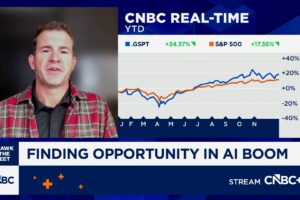
Investing.com — U.S. futures remain subdued on Monday at the start of a week which will bring Nvidia (NASDAQ:NVDA) earnings and inflation data that will likely cement expectations for September rate cuts.
1. Futures little changed with markets near records
U.S. stock futures were little changed on Monday as markets hovered near record highs after the Federal Reserve gave a clear signal that the long-awaited start of rate cuts would come next month.
By 03:48 ET (07:48 GMT), the Dow futures contract and the S&P 500 futures were both flat, while Nasdaq 100 futures rose by 35 points, or 0.1%.
Markets are coming off a strong week with the S&P 500′s Friday close putting the benchmark index less than 1% away from its all time high reached in mid July.
The three main indexes rallied after Fed Chair Jerome Powell that “the time has come” to lower the Fed funds target rate, and “the upside risks of inflation have diminished.”
The remarks appeared to all but guarantee a rate cut at the Fed’s September 18 meeting, which would be the first such cut in over four years.
2. U.S. data
This week the data-dependent Fed will have a raft of economic indicators to consider ahead of its September rate decision, including the Commerce Department’s revised second-quarter GDP and its broad-ranging Personal Consumption Expenditures (PCE) report, which includes the Fed’s preferred inflation yardstick, the PCE price index.
Friday’s PCE data will be closely watched though recent remarks by Fed policymakers have indicated that the Fed’s focus has shifted toward labor market risks and that inflation is close enough to target to facilitate cutting rates starting next month.
The economic calendar also includes a report on durable goods orders later Monday along with the weekly report on initial jobless claims on Thursday.
3. Nvidia earnings
The rally in U.S. markets will face a test when AI-darling Nvidia reports earnings after the close on Wednesday.
Nvidia stock is up some 150% year-to-date, accounting for around a quarter of the S&P 500’s 17% year-to-date gain. But the stunning, multi-year run and AI-mania have also drawn comparisons to the dot-com craze that imploded more than two decades ago.
The earnings report along with guidance on whether it expects corporate investments in AI to continue, could be a key inflection point for market sentiment heading into what is historically a volatile time of the year.
The results come at the end of an earnings season during which investors have taken a less forgiving view of big tech companies whose earnings failed to justify rich valuations or prodigious spending on AI.
4. Oil prices rise
Oil prices pushed higher on Monday amid concerns that any potential widening of the conflict in the Middle East could disrupt regional oil supplies, while the prospect of imminent U.S. rate cuts boosted the global economic and fuel demand outlook.
Brent crude futures climbed 74 cents, or 0.9%, to $78.89 a barrel by 03:48 ET (07:48 GMT) while U.S. crude futures were at $75.62 a barrel, up 75 cents, or 1.0%.
Both oil benchmarks gained more than 2% on Friday as expectations for September rate cuts by the Fed solidified.
But oil prices still ended last week lower as a poor outlook for major economies weighed on fuel demand.
Oil traders also remain cautious over plans by the Organization of Petroleum Exporting Countries (OPEC) and its allies, or OPEC+, to raise output later this year.
5. NASA snubs Boeing
NASA announced Saturday that it’s too risky to bring two astronauts stranded aboard the International Space Station back home in Boeing’s faulty new capsule and they will now return home in a SpaceX craft in early-2025.
Astronauts Butch Wilmore and Sunita Williams were stranded aboard the ISS in June after Boeing’s Starliner capsule seemingly malfunctioned during a test flight. The flight was initially planned to last a minimum of nine days but was delayed indefinitely as the agency raced to identify what went wrong with the Starliner.
NASA’s decision to proceed with SpaceX marks more trouble for Boeing (NYSE:BA), which was already facing heightened scrutiny over the safety standards of its commercial aircrafts.
SpaceX has contract with NASA to supply cargo to the ISS, and has completed nine successful missions to and from the ISS, as of April 2024.
–Reuters contributed reporting
Related Articles
Futures little changed, rate cut hopes and Nvida earnings – what’s moving markets
Australian employees now have the right to ignore work emails, calls after hours
Did Powell just pour gasoline on stock market’s fire?






